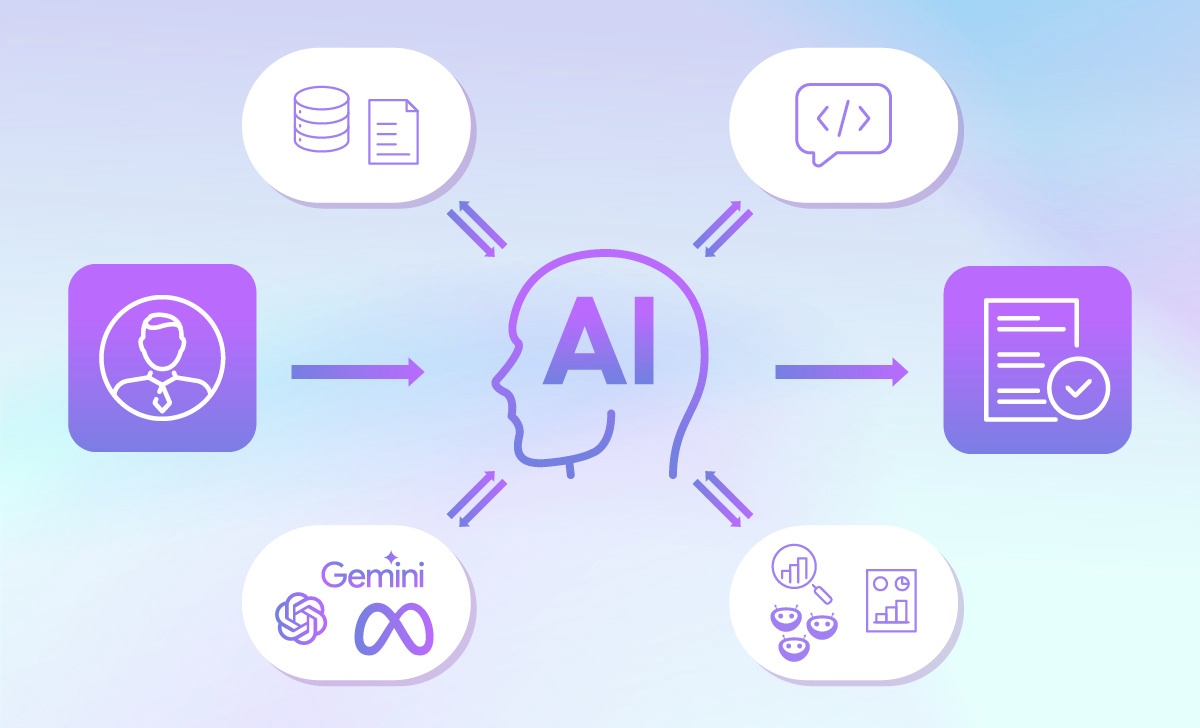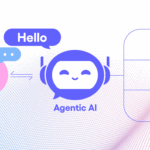Customer service is a practical test of how effectively an organization manages information and maintains trust. For years, support teams have relied on rule-based systems (ticket queues, scripted chatbots, and static knowledge bases) that lower costs but rarely solve the underlying inefficiency. They automate responses rather than understanding.
Agentic AI marks a turning point. These systems can interpret intent, recognize sentiment, retrieve information across platforms, and act autonomously to resolve issues. According to Gartner, by 2029 agentic AI will autonomously handle 80 percent of common customer service requests without human intervention. The figure captures both the scale of transformation and the risk of overreliance on autonomy without governance.
In this blog, we examine how agentic AI changes the design and execution of customer service operations. The discussion outlines its evolution beyond chatbots and rule-based flows, the core use cases where adoption delivers measurable impact, and the levels of autonomy that define agentic behavior. We also review the operational benefits and implementation challenges enterprises must address to deploy these systems responsibly.
TMO's agentic AI services include the creation of tailored AI workflows that help you collaborate, continuously optimize, and drive workplace productivity.
From Chatbots to Agents: How Automation Became Reasoning
Chatbots marked the first real automation of customer service. They handled routine requests, answered predictable questions, and reduced support costs at scale. Their success was measurable but narrow. Built on decision trees and keyword logic, chatbots could not interpret nuance or maintain context beyond a single exchange. They optimized response time, not understanding.
AI agents approach the task differently. They integrate language comprehension, reasoning, and system access to achieve defined objectives rather than follow prewritten scripts. An agent can interpret intent, pull data from multiple platforms, and act on it autonomously. It can also collaborate with other agents or human staff to complete a process end to end.
| Dimension | Chatbots | AI Agents |
|---|---|---|
| Purpose | Automate basic interactions | Achieve defined objectives across systems |
| Logic | Rule-based scripts and decision trees | Contextual reasoning and goal-oriented planning |
| Learning | Static; updates require manual input | Continuous learning from data and interactions |
| Context Retention | Limited to single conversation | Maintains memory across channels and sessions |
| Integration | Isolated from enterprise systems | Connected to CRMs, ERPs, analytics, and APIs |
| Collaboration | Operates alone | Coordinates with humans and other agents |
| Outcome | Faster replies | Autonomous resolution and optimization |
Chatbots automate dialogue; agents automate understanding and execution. The difference is not incremental but architectural: a move from reactive tools to active participants in the service process.
We previously wrote about AI in eCommerce and AI in eCommerce: 7 Magento Use Cases with Adobe Generative AIFrom agentic workflows to Adobe's GenAI solutions and third-party extensions, we explore the top AI use cases for your Magento eCommerce.7 Magento Use Cases with Adobe Generative AI
4 Core Use Cases in AI-Driven Customer Service
AI adoption in service operations generally begins with specific, repetitive workflows and expands toward systems that interpret, anticipate, and optimize. The following categories form the structural basis for that progression.
1. Customer Support and Ticket Handling
Agents can classify, route, and respond to tickets without human supervision. They interpret intent, extract key details, and update systems in real time. When escalation is required, they transfer the case with complete context, reducing redundancy and resolution time.
| Function | Traditional Workflow | Agentic Workflow |
|---|---|---|
| Ticket triage | Manual categorization | Automated classification by topic and urgency |
| Escalation | Agent reviews each case | AI escalates based on complexity and priority |
| Resolution | Prewritten scripts | Dynamic answers and system-level actions |
This use case shifts automation from simple routing to contextual decision-making, turning first contact into first resolution.
2. Sentiment Analysis and Feedback Monitoring
Agents monitor tone and emotion across text, chat, and voice channels. They detect dissatisfaction, predict churn, and adjust responses dynamically. The same analysis aggregates customer sentiment into quantifiable metrics that inform management decisions.
Key capabilities
- Detect sentiment in real time across multiple languages.
- Alert human supervisors when risk thresholds are exceeded.
- Adapt tone and content of automated responses.
- Generate trend reports on customer satisfaction and brand perception.
The result is a service environment that reacts to emotion as well as information.
3. Issue Detection and Anticipation
Predictive agents analyze data from logistics, payments, and product systems to identify disruptions before customers report them.
| Scenario | Agentic Action |
|---|---|
| Delivery delay | Notify affected customers and reschedule automatically |
| System outage | Generate incident ticket and status page update |
| Repeated complaint pattern | Flag root cause and recommend operational fix |
By shifting the focus from response to prevention, this use case converts customer service into a real-time quality control layer.
4. Knowledge and Documentation Management
Agents continuously update FAQs and support articles based on resolved cases. They identify information gaps, rewrite unclear content, and surface the most relevant entries during live interactions.
Operational outcomes
- Reduced average handle time for agents.
- Higher self-service success rates for customers.
- Knowledge consistency across departments and regions.
Individually, these use cases deliver measurable efficiency. Connected together, they form a self-reinforcing system: support generates data, sentiment analysis interprets it, predictive agents act on it, and knowledge management captures the improvement. The loop repeats, producing a service operation that learns and refines itself with each interaction.
TMO has 10+ years of experience helping brands grow with Digital Transformation Solutions tailored to their degree of digital maturity.
From Functions to Agents: What Modern AI Looks Like in Customer Service
The four functional areas described earlier (support automation, sentiment monitoring, issue detection, and knowledge management) represent the essential building blocks of AI in customer service. When implemented in isolation, each offers measurable improvement. When developed together, they form the foundation for modern AI agents: autonomous systems designed to manage outcomes, not just execute predefined tasks. These agents embody the shift from reactive support to coordinated, data-driven service.
Let's look at 4 modern implementations of AI agents:
| From Use Case to AI Agent | Core Functionality | Operational Value |
|---|---|---|
| Customer Support: Multi-Channel Service Agent | Consolidates chat, email, and social interactions into a unified environment. Interprets intent, retrieves information from CRM and order systems, and executes resolutions directly. | Provides consistent, real-time support across all channels while reducing first-response time and manual routing. |
| Sentiment Analysis: Retention Intelligence Agent | Monitors tone and emotion in every interaction. Detects frustration or churn risk and triggers tailored recovery workflows, loyalty offers, or escalation to senior agents. | Converts emotional signals into actionable interventions that strengthen retention and brand perception. |
| Issue Detection: Proactive Resolution Agent | Predicts potential service disruptions in logistics, payments, or systems. Diagnoses root causes and initiates preventive communication or task automation before customers report problems. | Transforms service from reactive troubleshooting to predictive assurance, reducing inbound volume. |
| Knowledge Management: Knowledge Curation Agent | Synthesizes insights from closed cases, updates FAQs and documentation, and surfaces verified answers for agents and customers in real time. | Maintains institutional knowledge accuracy and reduces handle time through reliable, continuously refreshed content. |
Each of these agents operates within its own domain yet contributes to a shared objective: seamless, intelligent service delivery. They communicate through shared data models, coordinate actions, and learn collectively from outcomes. The result is a support environment that behaves less like a series of tools and more like a team of specialists each with defined responsibilities, a memory of past interactions, and the ability to adapt over time.
This convergence of capabilities marks the beginning of true autonomy in customer service. The next consideration is how far that autonomy should extend and how to balance efficiency with oversight as agents begin to operate, decide, and improve on their own.
5 Levels of Agentic Behavior: Understanding Autonomy in AI Service
In addition, AI agents differ not only in what they do but in how independently they act. In the case of customer service, defining the correct level of autonomy determines whether technology enhances human capability or undermines it. The most effective deployments balance initiative with accountability: agents act freely within guardrails, but their reasoning and actions remain observable.
The five levels of agentic behavior below describe how independently an AI agent can act within human-defined boundaries:
| Level of Autonomy | Description | Typical Application in Customer Service | Human Involvement |
|---|---|---|---|
| Level 1: Operator | Executes commands exactly as given; no decision-making. | Macros, chatbots, or workflow triggers responding to keywords. | Full control; human initiates every action. |
| Level 2: Collaborator | Suggests next steps or drafts responses but awaits approval. | AI copilot generating replies, summaries, or ticket categories. | High; human validates each recommendation. |
| Level 3: Consultant | Acts on routine cases using learned patterns while deferring uncertain ones. | Automated triage and standard issue resolution. | Moderate; human reviews exceptions. |
| Level 4: Approver | Operates independently within policy thresholds; escalates only anomalies. | Proactive communication on known issues, refund processing under limits. | Low; human oversight through audit and alerts. |
| Level 5: Observer | Fully autonomous, coordinating with other agents and systems. | End-to-end issue detection, resolution, and feedback loops. | Minimal; monitoring for compliance and quality. |
As can be seen from the table, agents can range from low (Operator) to theoretically full (Observer) autonomy. Each level defines a different balance between initiative and supervision, showing how responsibility shifts from human-driven execution to agent-driven decision-making. The goal is not to reach “full autonomy” for its own sake, but to calibrate the right level of autonomy for the task, data environment, and risk tolerance.
Most enterprises today function between Levels 2 and 3, where agents assist rather than act. Moving higher on the scale demands transparent decision logic, verified data access, and defined escalation boundaries. Without these safeguards, autonomy increases speed but reduces trust.
For customer service leaders, the question is under what conditions should agents act alone. Establishing those boundaries early creates a sustainable framework where automation advances continuously without compromising accountability or customer confidence.
Benefits of Agentic AI in Customer Service
The introduction of agentic systems alters both the cost structure and the quality of customer service. When agents handle repetitive and predictable interactions, human teams shift toward high-value activities such as complex troubleshooting, escalation management, and customer retention. The resulting organization operates with fewer routine constraints and more analytical insight.
| Category | Primary Benefit | Supporting Mechanism |
|---|---|---|
| Efficiency and Cost Control | Lower handling time and reduced support volume. | Agents resolve recurring issues autonomously and manage workflows end to end. |
| Customer Experience and Retention | Faster response, consistent tone, and proactive outreach. | Sentiment monitoring and predictive communication prevent dissatisfaction before it escalates. |
| Scalability | Ability to handle increased interaction volume without proportional headcount. | Continuous learning and cross-system integration allow resource elasticity. |
| Data-Driven Improvement | Better visibility into service trends and operational bottlenecks. | Agents aggregate and analyze data from multiple systems to generate actionable insights. |
| Human Empowerment | Staff focus on problem-solving and relationship management instead of mechanical tasks. | Routine actions are delegated to agents while human oversight ensures quality and empathy. |
Across these dimensions, the benefit is cumulative. Efficiency gains improve morale and customer satisfaction, which in turn generate cleaner data and stronger predictive performance. Over time, each improvement reinforces the next, forming a cycle of learning and optimization.
The strategic advantage lies in precision. Agentic systems reveal where friction occurs, which interactions repeat unnecessarily, and where manual intervention still adds value. That information allows organizations to allocate resources more intelligently, reducing cost without diminishing service quality.
Beyond Automation: The Next Layer of Value
Once multiple agents operate together, their individual outputs begin to reinforce one another. Context flows from one function to the next: insights from customer support inform retention models, sentiment data guides proactive outreach, and knowledge updates improve the accuracy of every interaction. This integration generates compound value: efficiency through collaboration, learning through feedback, and resilience through shared memory.
| Emergent Outcome | Description | Operational Effect |
|---|---|---|
| Human–AI Collaboration | Agents act as copilots that recommend actions, summarize cases, and surface insights in real time while humans handle exceptions and relationship management. | Maintains empathy and accountability while improving throughput and decision speed. |
| Feedback Intelligence Loop | Data from customer interactions feeds back into product, marketing, and service design. | Converts service data into organization-wide learning, improving upstream processes. |
| Customer Impact Prediction | Systems model the potential reach and severity of operational issues. | Enables targeted, prioritized interventions before problems expand. |
| Knowledge Governance and Compliance | Verification layers monitor updates and ensure factual accuracy and regulatory alignment. | Preserves trust and auditability as automation scales. |
| Continuous Learning and Responsible AI | Agents refine behavior using supervised learning and feedback auditing. | Ensures adaptability without compromising transparency or ethics. |
The shift from isolated automation to networked intelligence marks the threshold of maturity in customer service. Each agent contributes data, decisions, and context to the others, allowing the system to improve autonomously while remaining accountable.
The value of such integration is durability. Rather than producing one-time efficiency gains, a coordinated agent ecosystem creates sustained operational competence, producing a service that becomes faster, more reliable, and more consistent every time it runs.
Build an Intelligence Service Core with AI Agents and TMO
Agentic AI defines a new operating model for customer service. Instead of disconnected automations performing single tasks, organizations now have the ability to design coordinated systems that perceive, decide, and act across their entire service chain. The result is a structure where human expertise and autonomous reasoning coexist, each reinforcing the other.
This evolution is neither speculative nor purely technological, presenting management with the questions of how to implement autonomy without losing control, and how to measure improvement without reducing service to metrics alone. Enterprises that succeed approach AI as part of their operating architecture, not as a plug-in. They build governance frameworks that track accuracy, fairness, and accountability with the same rigor as cost and efficiency.
When AI agents and human specialists share context and learn from each interaction, service quality improves cumulatively. The organization gains a durable advantage: faster resolution, consistent experience, and systems that grow smarter with use rather than degrading over time.
If you're wondering how AI can help your business' workplace productivity, decision-making, or sales, marketing, and customer service operations, reach out to us for a proposal tailored to your operational needs.








